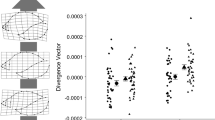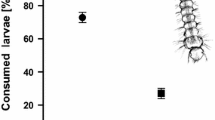Abstract
Many prey species face trade-offs in the timing of life history switch points like hatching and metamorphosis. Costs associated with transitioning early depend on the biotic and abiotic conditions found in the subsequent life stage. The red-eyed treefrog, Agalychnis callidryas, faces risks from predators in multiple, successive life stages, and can hatch early in response to mortality threats at the egg stage. Here we tested how the consequences of life history plasticity, specifically early hatching in response to terrestrial egg predators, depend on the assemblage of aquatic larval predators. We predicted that diverse predator assemblages would impose lower total predation pressure than the most effective single predator species and might thereby reduce the costs of hatching early. We then conducted a mesocosm experiment where we crossed hatchling phenotype (early vs. normal hatching) with five larval-predator environments (no predators, either waterbugs, dragonflies, or mosquitofish singly, or all three predator species together). The consequences of hatching early varied across predator treatments, and tended to disappear through time in some predation treatments, notably the waterbug and diverse predator assemblages. We demonstrate that the fitness costs of life history plasticity in an early life stage depend critically on the predator community composition in the next stage.



Similar content being viewed by others
References
Adolph EF (1931) Body size as a factor in metamorphosis of tadpoles. Biol Bull 61:376–386
Altwegg R, Reyer HU (2003) Patterns of natural selection on size at metamorphosis in water frogs. Evolution 57:872–882
Aubin-Horth N, Letcher NB, Hofmann HA (2009) Gene-expression signatures of Atlantic salmon’s plastic life cycle. Gen Comp Endocrinol 163:278–284
Baber MJ, Babbitt KJ (2004) Influence of habitat complexity on predator-prey interactions between the fish (Gambusia holbrooki) and tadpoles of Hyla squirella and Gastrophryne carolinensis. Copeia 1004:173–177
Bates D, Maechler M (2009) lme4: linear mixed-effects models using S4 classes. R package version 0.999375-32-2
Benard MF (2004) Predator-induced phenotypic plasticity in organisms with complex life histories. Annu Rev Ecol Evol Syst 35:651–673
Blaustein L (1997) Non-consumptive effects of larval Salamandra on crustacean prey: can eggs detect predators? Oecologia 110:212–217
Buckley CR, Michael SF, Irschick DJ (2005) Early hatching decreases jumping performance in a direct-developing frog, Eleutherodactylus coqui. Funct Ecol 19:67–72
Caraco T, Wolf LL (1975) Ecological determinants of group size of foraging lions. Am Nat 109:343–352
Chivers DP, Kiesecker JM, Marco A, DeVito J, Anderson MT, Blaustein AR (2001) Predator-induced life history changes in amphibians: egg predation induces hatching. Oikos 92:135–142
Christy JH (2011) Timing of hatching and release of larvae by brachyuran crabs: patterns, adaptive significance, and control. Integr Comp Biol 51:62–72
Corbet PS (1999) Dragonflies: behavior and ecology of Odonata. Cornell University Press, Ithaca
Dahl E, Orizaola G, Nicieza AG, Laurila A (2012) Time constraints and flexibility of growth strategies: geographic variation in catch-up growth responses in amphibian larvae. J Anim Ecol 81:1233–1243
De Block M, Stoks R (2008) Compensatory growth and oxidative stress in a damselfly. Proc R Soc B 275:781–785
Doody JS (2011) Environmentally cued hatching in reptiles. Integr Comp Biol 51:49–61
Finke DL, Denno RF (2004) Predator diversity dampens trophic cascades. Nature 429:407–410
Finke DL, Denno RF (2005) Predator diversity and the functioning of ecosystems: the role of intraguild predation in dampening trophic cascades. Ecol Lett 8:1299–1306
Griffiths D (1980) Foraging costs and relative prey size. Am Nat 116:743–752
Hector KL, Nakagawa S (2012) Quantitative analysis of compensatory and catch-up growth in diverse taxa. J Anim Ecol 81:583–593
Hentschel BT, Emlet RB (2000) Metamorphosis of barnacle nauplii: effects of food variability and a comparison with amphibian models. Ecology 81:3495–3508
Holland JG, Guidat FS, Bourke AFG (2013) Queen control of a key life-history event in a eusocial insect. Biol Lett 9:20130056
Juliano SA, Olson JR, Murrell EG, Hatle JD (2004) Plasticity and canalization of insect reproduction testing alternative models of life history. Ecology 85:2986–2996
Komak S, Crossland MR (2000) An assessment of the introduced mosquitofish (Gambusia affinis holbrooki) as a predator of eggs, hatchlings, and tadpoles of native and nonnative anurans. Wildl Res 27:185–189
Kusch RC, Chivers DP (2004) The effects of crayfish predation on phenotypic and life-history variation in fathead minnows. Can J Zool 82:917–921
Li D (2002) Hatching responses of subsocial spitting spiders to predation risk. Proc R Soc B 269:2155–2161
Mangle M, Munch SB (2005) A life-history perspective on the short- and long-term consequences of compensatory growth. Am Nat 166:E155–E176
Martin K, Bailey K, Moravek C, Carlson K (2011) Taking the plunge: California grunion embryos emerge rapidly with environmentally cued hatching (ECH). Integr Comp Biol 51:26–37
McCoy MW, Bolker BM, Warkentin K, Vonesh JR (2011) Predicting predation through prey ontogeny using size-dependent functional response models. Am Nat 177:752–766
McPeek MA, Crowley PH (1987) The effects of density and relative size on the aggressive behaviour, movement and feeding of damselfly larvae (Odonata: Coenagrionidae). Anim Behav 35:1051–1061
Metcalfe NB, Monaghan P (2001) Compensation for a bad start: grow now, pay later? Trends Ecol Evol 16:254–260
Miner BG, Donovan DA, Andrews KE (2010) Should I stay or should I go: predator- and conspecific induced hatching in a marine snail. Oecologia 163:69–78
Morgan IJ, Metcalfe NB (2001) Deferred costs of compensatory growth after autumnal food shortage in juvenile salmon. Proc R Soc B 268:295–301
Newman RA (1992) Adaptive plasticity in amphibian metamorphosis. Bioscience 42:671–678
Ohba SY, Hidaka K, Sasaki M (2006) Notes on paternal care and sibling cannibalism in the giant water bug, Lethocerus deyrolli (Heteroptera: Belostomatidae). Entomol Sci 9:1–5
Orizaola G, Dahl E, Laurila A (2010) Compensating for delayed hatching across consecutive life-history stages in an amphibian. Oikos 119:980–987
Peckarsky BL, Taylor BW, McIntosh AR, McPeek MA, Lytle DA (2001) Variation in mayfly size at metamorphosis as a developmental response to risk of predation. Ecology 82:740–757
Pruthi HM (1925) Moulting of insects. Nature 116:938
Rasband WS (1997) ImageJ. U. S. National Institutes of Health, Bethesda, MD, http://imagej.nih.gov/ij/, 1997–2012
Relyea RA (2003) How prey respond to combined predators: a review and an empirical test. Ecology 84:1827–1839
Rowe L, Ludwig D (1991) Size and timing of metamorphosis in complex life cycles: time constraints and variation. Ecology 72:413–427
Schmitz OJ (2007) Predator diversity and trophic interactions. Ecology 88:2415–2426
Sih A, Moore RD (1993) Delayed hatching of salamander eggs in response to enhanced larval predation risk. Am Nat 142:947–960
Sih A, Crowley PH, McPeek MA, Petranka JW, Strohmeier K (1985) Predation, competition, and prey communities: a review of field experiments. Annu Rev Ecol Syst 16:269–312
Sih A, Englund G, Wooster D (1998) Emergent impacts of multiple predators on prey. Trends Ecol Evol 13:350–355
Smith RL (1974) Life history of Abedus herberti in Central Arizona (Hemiptera: Belostomatidae). Psyche 81:272–283
Smith GR, Fortune DT (2009) Hatching plasticity of wood frog (Rana sylvatica) eggs in response to mosquitofish (Gambusia affinis) cues. Herpetol Conserv Biol 4:43–47
Soluk DA (1993) Multiple predator effects: predicting combined functional response of stream fish and invertebrate predators. Ecology 74:219–225
Stoks R, De Block M, McPeek MA (2006) Physiological costs of compensatory growth in a damselfly. Ecology 87:1566–1574
Touchon JC, Warkentin KM (2010) Short- and long-term effects of the abiotic egg environment on viability, development and vulnerability to predators of a Neotropical anuran. Funct Ecol 24:566–575
Touchon JC, Gomez-Mestre I, Warkentin KM (2006) Hatching plasticity in two temperate anurans: responses to a pathogen and predation cues. Can J Zool 84:556–563
Touchon JC, Urbina J, Warkentin KM (2011) Habitat-specific constraints on induced hatching in a tree frog with reproductive mode plasticity. Behav Ecol 22:169–175
Touchon JC, McCoy MW, Vonesh JR, Warkentin KM (2013) Effects of hatching plasticity carry over through metamorphosis in red-eyed tree frogs. Ecology 94:850–860
Urban MC (2007) The growth-predation risk trade-off under a growing gape-limited predation threat. Ecology 88:2587–2597
Van Buskirk J (1992) Competition, cannibalism, and size-class dominance in a dragonfly. Oikos 65:455–464
van Uitregt VO, Hurst TP, Wilson RS (2012) Reduced size and starvation resistance in adult mosquitoes, Aedes notoscriptus, exposed to predation cues as larvae. J Anim Ecol 81:108–115
Vonesh JR, Bolker BM (2005) Compensatory larval responses shift trade-offs associated with predator-induced hatching plasticity. Ecology 86:1580–1591
Warkentin KM (1995) Adaptive plasticity in hatching age: a response to predation risk trade-offs. Proc Natl Acad Sci USA 92:3507–3510
Warkentin KM (1999) Effects of hatching age on development and hatchling morphology in the red-eyed tree frog, Agalychnis callidryas. Biol J Linn Soc 68:443–470
Warkentin KM (2000) Wasp predation and wasp-induced hatching of red-eyed tree frog eggs. Anim Behav 60:503–510
Warkentin KM (2011a) Environmentally cued hatching across taxa: embryos respond to risk and opportunity. Integr Comp Biol 51:14–25
Warkentin KM (2011b) Plasticity of hatching in amphibians: evolution, trade-offs, cues and mechanisms. Integr Comp Biol 51:111–127
Warkentin KM, Caldwell MS (2009) Assessing risk: embryos, information, and escape hatching. In: Dukas R, Ratcliffe J (eds) Cognitive ecology. II. The evolutionary ecology of learning, memory, and information use. University of Chicago Press, Chicago, pp 177–200
Werner EE (1986) Amphibian metamorphosis: growth rate, predation risk, and the optimal size at transformation. Am Nat 128:319–341
Werner EE, Gilliam JF (1984) The ontogenetic niche and species interactions in size-structured populations. Annu Rev Ecol Syst 15:393–425
Willink B, Palmer MS, Landberg T, Vonesh JR, Warkentin KM (2013) Environmental context shapes immediate and cumulative costs of risk-induced early hatching. Evol Ecol. doi:10.1007/s10682-013-9661-z
Zuur AF, Ieno EN, Walker NJ, Saveliev AA, Smith GM (2009) Mixed effects models and extensions in ecology with R. Springer, Berlin Heidelberg New York
Acknowledgments
We thank the Autoridad Nacional del Ambiente de Panamá for permission to conduct this research (permit SC/A-73-09). We would like to thank M. Hughey, K. Warkentin, and M. McCoy for their advice and assistance. L. Belden, as well as the reviewers and editors, made helpful suggestions to improve the manuscript. J. M. W. and B. M. were supported by a Research Opportunity Award from the National Science Foundation, stemming from NSF grant 0717220 to J. R. V; J. C. T. was supported by NSF grant IIA-1064566. Virginia Commonwealth University, Radford University, and the Smithsonian Tropical Research Institute also provided funding or support.
Author information
Authors and Affiliations
Corresponding author
Additional information
Communicated by Anssi Laurila.
Electronic supplementary material
Below is the link to the electronic supplementary material.
Rights and permissions
About this article
Cite this article
Wojdak, J.M., Touchon, J.C., Hite, J.L. et al. Consequences of induced hatching plasticity depend on predator community. Oecologia 175, 1267–1276 (2014). https://doi.org/10.1007/s00442-014-2962-2
Received:
Accepted:
Published:
Issue Date:
DOI: https://doi.org/10.1007/s00442-014-2962-2




